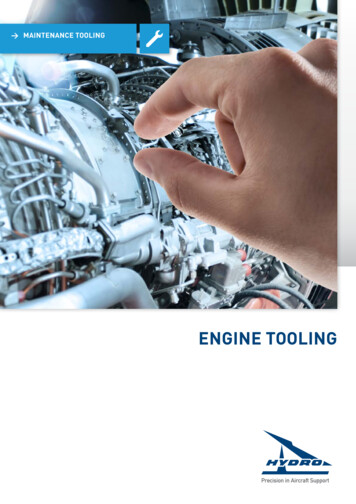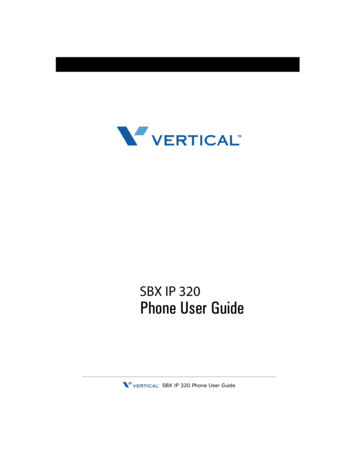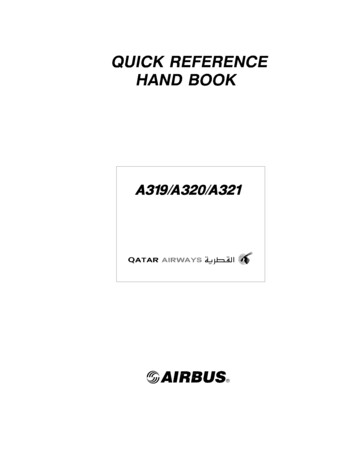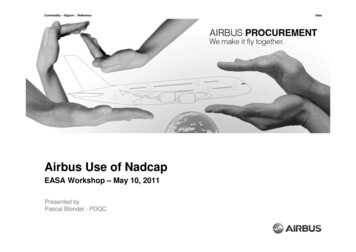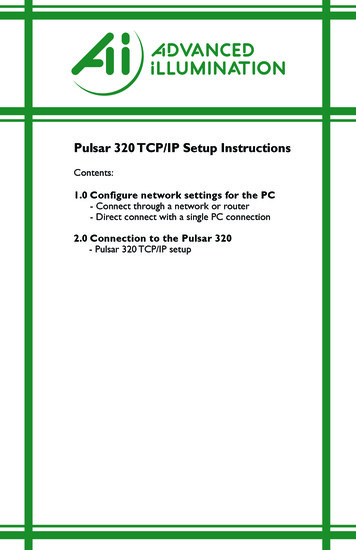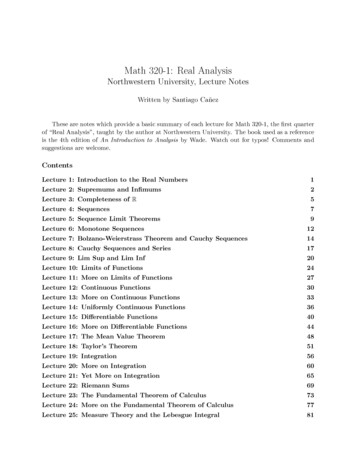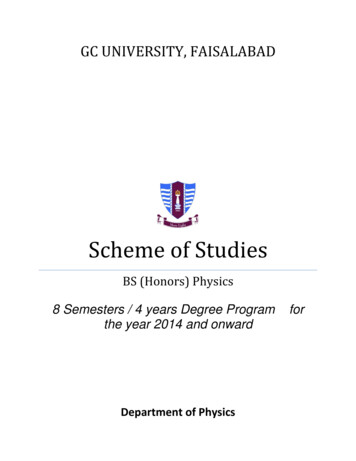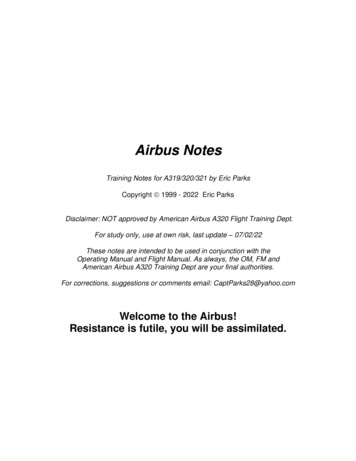
Transcription
Airbus NotesTraining Notes for A319/320/321 by Eric ParksCopyright 1999 - 2022 Eric ParksDisclaimer: NOT approved by American Airbus A320 Flight Training Dept.For study only, use at own risk, last update – 07/02/22These notes are intended to be used in conjunction with theOperating Manual and Flight Manual. As always, the OM, FM andAmerican Airbus A320 Training Dept are your final authorities.For corrections, suggestions or comments email: CaptParks28@yahoo.comWelcome to the Airbus!Resistance is futile, you will be assimilated.
American Airlines Airbus A319, A320, A321 NotesTable of ContentsTable of Contents 2Limits 5Systems 8Ice & Rain Protection (ASM 13) 8Electrical (ASM 7) 9Fire Protection (ASM 8) 13Fuel (ASM 11) 15Air Conditioning, Pneumatics & Pressurization (ASM 3) 20Pressurization 22Hydraulics, Brakes & Landing Gear (ASM 12 & 14) 25Flight Controls (ASM 9) 30Instrument / Nav / Comm (ASM 10) 38ECAM 38ECAM Procedures: 39Tune, Talk, Listen – RMP and ACP 50Auto Flight System (ASM 5) 51FMA – Flight Mode Annunciator 61Oxygen (ASM 16) 62Powerplant (ASM 17) 63APU (ASM 4) 65FMS (Controls and Indicators ASM 5) 66Pseudo Waypoints 71Initializing the FMGC 72Phase Triggers 78Reroutes 79Takeoff 85V1 Cuts 89FMS Engine Failure Procedures 90Approaches 92ILS Approaches 97LDA Approaches 972
American Airlines Airbus A319, A320, A321 NotesPRM Approaches 102Non-ILS Approaches 104RNAV Approaches 105Procedures for Non-ILS, Non-Managed Approaches: 108VOR/NDB approaches 109Engine-Out Approaches 110Visual Approaches 111Go Around 112Landing 114Maneuvers 116A to Z - Abbreviations & Acronyms 123FM Stuff 128Note:AOM is Aircraft Operating Manual, how to operate the A320ASM is Aircraft Systems Manual, how the systems on the A320 workFOM is Flight Operations Manual, policies and procedures to be a great AA pilotNote: I have attempted to align the Notes with all the newly changed documents listedabove. I’m sure I have missed a few so please feel free to inform me of where I need toupdate references to company material.3
American Airlines Airbus A319, A320, A321 NotesAuthors notes:These notes are not intended to be a comprehensive look at every aspect of theA319/320/321. I only intend them to cover the basics. They assume an already highlevel of experience with advanced aircraft systems. I hope they help in studying for initialor recurrent or as a quick reference during line operations. They are written from theviewpoint of an American Airlines Line pilot because that is who I am. I have includedwhat I find helpful. If you find something that you feel should be included or correctedplease let me know as I am always seeking to “improve the product”.Eric ParksCaptParks28@yahoo.comCaution!The information given here is specifically tailored to American A319/320/321 operations.If you fly for another airline or operator your procedures, numbers and/or limits may bedifferent. Always check with your airline’s or operator’s documentation before usinganything here. Be sure you are always compliant with your company’s procedures andlimits.Permission is given to distribute or copy these notes under the following conditions: Nothing may be charged for the notesNo changes may be made without express consent of the authorAuthors copyright must be includedTrust in the LORD with all thine heart; and lean not unto thineown understanding. In all thy ways acknowledge him, and heshall direct thy paths. Proverbs 3:5,64
American Airlines Airbus A319, A320, A321 NotesLimits(memory items in bold italics, (A) stands for American imposed limit)Weight Limits (AOM 18.2.3)(in lbs.)Max Ramp:Max Takeoff:Max Landing:Max Zero 06166,669Operational / Wind Limits (AOM 18.2.1, 18.2.4)Max wind for takeoff and landing (inc. gusts):50 kts. (A)Max crosswind for Takeoff or Landing:35 (A)Max tailwind for takeoff (all A319 & A320/A321 CFM):15 kts.Max tailwind for takeoff (A320/A321 IAE engines):10 kts.Max tailwind for landing (Sharklet):15 kts.Max tailwind for landing (non-Sharklet):10 kts.Max operating altitude:39,000 ft. (A)Max landing gear extension altitude:25,000 ft.Max operating altitude w/ slats and/or flaps extended:20,000 ft.Note: use Wind Limitations chart in QRH for Crosswind Limits in ContaminatedRunway, Low Visibility (below 4000 RVR) or Autoland conditions.Speed Limits (AOM 18.2.2)Max operating speed (VMO):Max operating speed (MMO):350 KIAS.82 M (MMO)Max gear extended (VLE):Max gear extension (VLO):Max gear retraction (VLO):Max windshield wiper operations speed (VWW):Max window open speed (who is going to open it?):Max tire speed:Max taxi speed:Max taxi speed for 90 turn:280 KIAS / .67M250 KIAS220 KIAS230 KIAS200 KIAS195 kts.30 kts. (A)10 kts. (A)Turbulence Penetration –(AOM 18.2.2)A319/320A321below 20,000 ft.:at or above 20,000 ft.:250 KIAS270 KIAS275 KIAS / .76M300 KIAS / .76M5
American Airlines Airbus A319, A320, A321 NotesMax Flaps / Slats (VFE) (AOM 18.2.2):ModelPosition:1A319/320 VFE KIAS230A321VFE KIAS235A321NX VFE KIAS2431 F21522522522002152153185195195FULL177190186Note: use VFE Next -10 as limit for flap extension (A)Note: VFE Next is the Amber equals sign on the airspeed scaleEngine Start Crosswind limit: LEAP-1A 45 kts, CFM-56, IAE: 35 kts.Ice & Rain Protection (AOM 18.5)Engine anti-ice must be on during all ground and flight operations when icingconditions exist (and prior to descent into icing conditions) except during climband cruise when the temperature is:below -40 C SATIcing conditions exist on ground:Icing conditions exist in flight:OAT 10 C (50 F) or belowTAT 10 C (50 F) or belowFuel (AOM 18.14)(6.676 lbs. per gal.)Wing tanks:Center tank:Additional Center tanks:Total useable fuel:A319/A32027,500 lbs14,500 lbs.N/A42,000 lbs.A32127,500 lbs.14,500 lbs.10,500 lbs.52,500 lbs.Fuel ManagementCenter tank fuel must be emptied before wing tanks are emptied (unless centertank fuel is being used as ballast). (A)Takeoff on center tank fuel is prohibitedA321: If center tank is not full, dispatch with more than 200 lbs. fuel in both ACTsis prohibited, unless directed by MEL. (A)Air Systems (AOM 18.4.1)Do NOT use external conditioned air simultaneously with the air packsExcept in A321T, do NOT put animals in cargo compartment (A)6
American Airlines Airbus A319, A320, A321 NotesAutopilot / Autoland (AOM 18.6) Autopilot Minimum Height in ft.:Min altitude after takeoff (if SRS is indicated)100 ft. AGL(Note: internal logic prevents autopilot engagement for 5 seconds after liftoff)Enroute (A319, A320):500 ft. AGLEnroute (A321):900 ft. AGLCAT I ILS (CAT I / CAT II or III in FMA)160 / 80 ft. AGLNon-precision approachDA, DDA or MDAAfter Manual Go-Around in SRS100 ft. AGLEngine Out Autoland: CATIII SingleEngine Out Autoland: A320 config FULL ONLY, A319 & A321 config 3 and FULLMax Winds for Autoland (including gusts) QRH “Blue Pages” & AOM 18.2.4Headwind A31920 knots,15 single engineTailwind A319 Non-Sharklet below 5,750’ MSL and Config FULL10 knotsTailwind A319, all other configurations5 knotsCrosswind A319 vis 4000, ¾, A31920 knots,10 single engineCrosswind A319 vis 4000, ¾, A31915 knots,10 single engineHeadwind A320, A321Tailwind A320, A321Crosswind vis 4000, ¾, A320, A321Crosswind vis 4000, ¾, A320, A32130 knots,10 knots20 knots,15 knots,A321NX 15 knotsA321NX 10 knotsA321NX 10 knotsRVSM Altimeter tolerances (AOM 18.2.1)Ground Check: PFD 1 and 2 within plus/minus 75 ft. of known airport altitudeMax difference between PFD 1 and 2 within 20 ft.In Flight: Max difference between Capt’s. and F/O’s PFD for RVSM is 200 ft.MiscellaneousMax brake temp for takeoff, fans OFF (AOM 18.15.2)Min engine oil for dispatch (AOM 18.10.5)300 C13 qtsCrew Oxygen Pressure, if Oxygen Pressure is below 1000 PSI consult chart inAOM 18.3.5.Climb Speeds (not limits but I just wanted to include them here)Max Angle of Climb: EXPED pb -or- OP CLB and Green DotMax Rate of Climb: OP CLB and A319/A320: 260/.76M, A321 280/.76M7
American Airlines Airbus A319, A320, A321 NotesSystemsNote: pb stands for pushbutton (NOT peanut butter!) and there are lots of ‘em!Ice & Rain Protection (ASM 13)Wing Anti-ice Wing anti-ice heats the three outer wing slat panels on each wing.Wing A-I is available for single-engine (if Engine Fire pb not pushed) by usingpack off and crossbleed open as per. Use Wing Anti-Ice when icing is occurring(build up on windshield wiper nut or wing)Wing A-I valves close automatically: On touchdown Leak detected Electrical power lostIn normal use select Wing Anti-Ice (AOM 15.8.6): On after thrust reduction on take-off Off at FAF during approachEngine Anti-ice (AOM 18.5.1, 15.8.4) – In flight or on ground at or below 10 C (50 F) with visible moisture/possibleingestion (AOM 18.5.1, 18.5.2). Not required during flight in climb or cruisebelow -40 C SAT (-40 F SAT). Do not use on ground above 10 C.Engine A-I ducting is independent of wing A-I. Engine A-I valves will openautomatically on loss of electrical power. They close automatically with airpressure not available (engine not running). Engine limits are automatically resetwhen Engine A-I selected. Engine Ignition will come on automatically whenEngine Anti-Ice is selected ON with IAE engine aircraft and CFM non-upgradedFADEC aircraft. On CFM aircraft with new upgraded FADEC’s the ignition willonly come on when FADEC detects certain parameters being exceeded. UseEngine Anti-ice prior to entering icing conditions.Probe and Mast Heat / Window Heat / Rain RemovalAll heat is turned on at low power on ground after the first engine start. In flight allheat automatically goes to High. Can turn on manually on ground before enginestart by pressing pb to ON. Deselect to Auto after second engine start.Note: when on ground a windshield (or window) heat fault may be given due toheating by the sun. Cool the cockpit (or stow shades) and reset the WHC circuitbreaker. Rain repellant is inhibited on the ground with engines shut down.8
American Airlines Airbus A319, A320, A321 NotesElectrical (ASM 7)All normal electrical power shifts automatically except the External Power whichmust have the EXT PWR pushbutton selected to supply power to the AC bus tie.The External Power (EXT PWR) pb will show green AVAIL when power isconnected and OK. The pilot must press the pb to manually select external. Oncepressed the EXT PWR pb will show blue ON indicating that external is nowpowering the aircraft. When you wish to switch to ships power first ensure that apower source is available, normally the APU. Then press the EXT PWR pb. It willchange from blue ON to green AVAIL as the APU (or engines) begin to supplypower. Once the external power has been deselected and the green AVAIL isshowing in the pb you may disconnect the external power.New Airbus pilots will sometimes find it hard to remember that the green AVAILdoes NOT mean that EXT PWR is powering the aircraft. Blue ON indicates thatexternal is powering the aircraft. Airbus Gotcha: Just to make things interesting Airbus has used the same pb’sfor the APU Start pb as the External Power pb. The MASTER SW APU blue ONis the “APU Master Switch” and just indicates the APU is prepared to start. Theblue ON for the APU START pb means the APU is actually starting. The greenAVAIL in the APU START pb shows that the APU is available for use and poweris OK and the APU will automatically pick up the electrical load unless you are onexternal (remember, EXT PWR requires a manual power shift). So for the APUSTART green AVAIL can be showing in the pb when powering the aircraft, theopposite of the EXT PWR pb green AVAIL. The point here is that green AVAILcan mean something different on these two pb’s. This is just a reminder as theAPU panel is not part of the Electrical panel.Normal priority for AC BUS power is: (work across ELEC panel from GEN 2)1)2)3)4)5)6)On-Side (respective) engine generatorExternal PowerAPU generatorOff-Side (opposite) engine generatorEmergency Generator (RAT)BatteriesThe only way to power both AC busses from a single power source is through theAC BUS TIE. The APU and EXT PWR both feed the AC BUS TIE. Both ACbusses connect to the AC BUS TIE as needed. APU will automatically power ACunless the EXT PWR or ENG GEN is on. If both IDG’s are available then the ACbusses will not be connected to the AC BUS TIE. If only one ENG GEN (no APUor EXT PWR) is available the opposite AC bus will connect to it through the ACBUS TIE.9
American Airlines Airbus A319, A320, A321 NotesThe Electrical system is divided into two main branches. Both AC and DC arenormally separated into two branches with Engine 1 driving IDG (integrated drivegenerator) 1 and IDG 1 feeding AC BUS 1. AC BUS 1 then feeds DC BUS 1through TR 1 (transformer rectifier). The same happens on side 2.As long as each engine IDG is available then the two sides remain electricallyisolated. If there is a loss of power on an AC bus then the remaining poweredbus will automatically power the unpowered AC bus through the AC BUS TIE. Ifthe APU is then started it will automatically power the bus tie and the failed ACbus. The AC BUS TIE will then be isolated from the normal powered bus. IDGshould not be disconnected when engine not turning (operating or windmilling)and the IDG disconnect should not be pressed more than 3 seconds. IDG canonly be reconnected on the ground.In case of TR failure the DC busses can be automatically connected through theDC BAT BUS.Two batteries are installed. Battery charging is automatic and is controlled by theBCL (Battery Charge Limiter). The BCL connects the battery to its respective DCBAT BUS during battery charging and during APU start. The batteries have anautomatic cut-off logic to prevent complete battery run-down when the aircraft isunpowered and on the ground. This will shut off the batteries at about 22.5vcapacity to ensure APU start after overnight.Min Battery voltage is 25.5v. During the Electric Power Up Procedure checkbattery voltage with the BAT switch OFF. To charge batteries turn them on bypressing their respective pb’s and connecting external power. A 20 min. charge isrequired if BAT voltage is not enough. If BAT ONLY start APU must be startedwithin 30 minutes of selecting BAT to AUTO.Part of the normal procedures for the Origination Flow calls for the check of bothbatteries to make sure that they are charging properly. Turn off each battery andthen turn them back on. Watch on the ECAM ELEC page to see that bothbatteries have initial current charge rates after 10 seconds of less than 60 ampsand decreasing (OM II 2a.3.3).If all AC (no RAT) is lost a static inverter is connected from HOT BAT 1 bus toAC ESS bus (not SHED bus). BAT 2 will supply DC ESS (not SHED) in the eventof loss of all AC (no RAT emerg. gen.) regardless. Below 50 kts. AC ESS will nolonger be supplied by the inverter and will be unpowered. DC BAT will connectbelow 100 kts., it is not supplied above 100 kts. in loss of all AC.If both Main AC busses lose power and the airspeed is 100 kts. or more the RATwill automatically deploy. The emergency generator will then power AC ESS BUSand DC ESS BUS. During the 8 seconds it takes the RAT to deploy and supplypower the batteries will supply the ESS busses (not their shed busses) and the10
American Airlines Airbus A319, A320, A321 Notesred FAULT light on the EMER ELEC PWR panel will be on during those 8seconds. The RAT emergency generator is lost at landing gear down (unmodifiedA320) or less than 125 kts (A319, modified A320, A321) and ND1 and MCDU1will go out at that time due to loss of AC shed bus. On landing the DC BAT bus isautomatically connected to the batteries when airspeed drops below 100 kts.When all AC is lost including the RAT emergency generator BAT 1 will supply ACESS through the static inverter and BAT 2 will supply DC ESS. When the speeddrops below 50 kts. the AC ESS bus is shed and power is lost to remainingCRT’s (PFD1, ECAM upper). Note: min. RAT speed is 140 kts, RAT will stall outat less than 125 kts on A319, A321 and modified A320. However, the RAT willcontinue to supply hydraulic pressure even after it is unable to power theemergency generator. The RAT is normally deployed automatically for electricalproblems, however pressing the MAN ON red guarded pb on the EMER ELECPWR panel will deploy the RAT and hydraulically power the EmergencyGenerator. If you need to reset the Emergency Generator after the RAT hasbeen deployed (such as go-around after gear has been deployed) press theRAT MAN ON pb again and this will allow the Emergency Gen to reset and comeback online.AC BUS 1 normally supplies power to AC ESS , TR 1 and DC BUS 1 whicheventually feeds DC ESS. If AC BUS 1 fails the pilot may press the AC ESSFEED pb to ALTN (in some aircraft this switches automatically). This will put theAC ESS BUS on it’s alternate source, GEN 2 through AC BUS 2. AC EssentialFeed will automatically switch on some aircraft as installed. ECAM will directwhether to repower AC ESS or to leave it unpowered. AC BUS 2 will then alsosupply power to DC ESS BUS from the AC ESS BUS through the ESS TRUwhen on ALTN.If TR1 fails the DC BAT BUS and DC BUS 1 will become automatically poweredby DC BUS 2 which will automatically connect to the DC BAT BUS.APU will carry all busses on ground but will not supply main galley shed bussesin-flight. In-flight if only one generator is supplying entire system then part (321:all galley power) of the galley load and passenger in-seat power supply is shed.GEN 1 Line (7.1.9) – If there is smoke in the avionics compartment the amberSMOKE light will come on in the GEN 1 LINE pushbutton. The procedure will callfor the pilot to press the pb. This will open the GEN 1 line contactor and depowerAC bus 1. GEN 2 will then automatically pick up AC BUS1 through the AC BUStie. However, GEN 1 will still be powering two wing fuel pumps, one in each winginner tank. Note: this is not the complete smoke procedure, just the beginningthat deals with the GEN 1 LINE pb.In loss of all AC (RAT only) emergency the APU is allowed 3 min. for start afterEMERG GEN connects. The APU will not start in-flight when on BAT only (this isdue to the DC BAT BUS being disconnected during Electrical Emergency11
American Airlines Airbus A319, A320, A321 Notesconfiguration above 100 kts.). Lights available in loss of all AC emergency areCapt. instrument lights, F/O dome light (if on DIM or BRT) and compass/ice light.If any generator is operating at more than 100% rated load the GALY & CAB (orGALLEY) pb will illuminate amber FAULT. You will be directed to select OFFwhich will then load shed by offloading the main galley, secondary galley and thein-seat power supply. In AUTO (normal blank) pb position the main galley (A319& A320) or all galleys (A321) and inseat power supplies will automatically loadshed if in-flight with one generator operating or on the ground with only oneengine generator operating. If APU gen or EXT PWR is supplying power then allgalleys are powered.Commercial pb (A321 only) when pushed will depower all commercial electricalsystems (Cabin & Cargo lights, Water & Toilet system, Drain mast ice protection,Galley, Passenger entertainment).Circuit breakers are color coded. Green are monitored by ECAM. All other colorsare not monitored. The ECAM will display C/B TRIPPED ON OVHD PNL (orREAR PNL) if a green monitored breaker is tripped for more than a minute.Yellow breakers are pulled during the procedure for flight on battery power only.Red capped breakers are NEVER pulled in flight. Red caps are installed on thewing tip brakes circuit breakers to prevent loss of flap asymmetry protection. Allcircuit breakers have a letter (horizontal) and number (vertical) code.When on the gate with normal APU or EXT PWR (AC established) the GEN 1 &2 amber FAULT lights will normally be the only amber FAULT lights on in theoverhead panel (with packs ON). With packs OFF the GEN 1 & 2 amber FAULTand the PACK 1 & 2 amber FAULT lights will be on.When shutting down the APU and turning off BATs allow 2 min. after APU GreenAVAIL light goes out to allow time for APU flap to close (OM 3.16).Batteries must always be on when APU is running for fire protection.Ain’t no magic when the electrons stop! Bottom line here, ya gotta have electricalsomehow! Make sure you have a GEN, EMER GEN or at least a BAT or yoursidestick just became a worthless piece of plastic!12
American Airlines Airbus A319, A320, A321 NotesFire Protection (ASM 8)Both engines and the APU each have two identical loops, A & B and a computerFDU (Fire Detection Unit). A fire warning is given when both loops reach theproper overheat condition. If one loop fails the other loop is able to generate thewarning by itself. A fire warning is given if both loops fail within 5 seconds of eachother. There is a red disc on the aft fuselage to show thermal discharge for theAPU fire bottle. The engines each have two extinguishers, the APU one. Engineshave sensing elements in three sections; pylon nacelle, engine core and fansection. APU has sensing element in APU compartment.APU fire on ground will auto shutdown, blow extinguisher bottle, sound nosewheel well horn and APU FIRE light will illuminate on external interphone panel.APU fire in-flight must be manually shutdown (will not auto shutdown) andextinguished. Note: APU will auto shutdown in air for other than fire (go figure).The forward cargo compartment has two smoke detectors and the aft has four(319,320). The 321 has four forward detectors and six detectors in the aft cargo.In either case two loops. Agreement of two smoke detectors on a loop will givewarning. If one smoke detector fails the system remains operational on theremaining detector. There is one extinguisher bottle (Note: ETOPS aircraft willhave two bottles) for fore and aft compartments with one nozzle forward and twonozzles aft. Halon will last about an hour from one bottle. If cargo SMOKE iswarning is given an isolation valve will close and the extraction fan will stop.Cargo smoke gives: CRC, Master Warn light and Cargo SMOKE light.ENG fire test: (7 items – 4 reds) (OM II 8.2.1)ENG 1 Test – press and hold ENG FIRE pb illuminated (red) SQUIB and DISCH lights illuminated (2) MASTER WARN illuminated (2) (red) CRC aural chime ENG 1 FIRE warning on E/WD (red) ENGINE page on SD FIRE light ENG 1 (on ENG panel) illuminated (red)Repeat for ENG 2APU fire test: (BAT only 2 items – 1 red, AC 6 items – 3 red) (OM II 8.2.2)APU FIRE Test – press and hold (APU will not shutdown during test if running)13
American Airlines Airbus A319, A320, A321 Notes APU FIRE pb illuminated (red) * SQUIB and DISCH light illuminated * MASTER WARN lights illuminated (2) (red) CRC aural chime APU FIRE warning on E/WD (red) APU page on SD* BAT only (when doing Electrical Power Up procedure on Battery only, noExternal power)ENG FIRE pb pressed performs: (work down panel with 2,1,2,1,2 sequence –two on FIRE, one on HYD, two on FUEL, one on ELEC, two on AIR COND)FIRE HYD –FUEL ELEC AIR COND-Silences CRC, Arms squibsCloses hydraulic fire valveCloses low pressure fuel valve and turns off FADECDeactivates the IDGCloses engine bleed & pack flow valves(2)(1)(2)(1)(2)APU FIRE pb pressed performs: (work down panel with 3, 0, 2,1,2 sequence)FIRE HYD FUEL ELEC AIR COND-Silences CRC, Shuts down APU, Arms squibCloses low pressure fuel valve & APU fuel pump offDeactivates APU GENCloses APU bleed & Crossbleed valves(3)(0)(2)(1)(2)Cargo Smoke Detector test - press & release button for test. You should get (OMII 8.2.7): DISCH amber lights illuminate.SMOKE red lights illuminate (2X)MASTER WARN light illuminateCRC auralCARGO SMOKE on E/WDThis test will run twice after you select it once to test both channels. Note: DISCHamber lights only on first test.If the CARGO SMOKE bottle is fired the indications you can expect are:Red SMOKE light remains on (smoke & bottle discharge are trapped)Both amber DISCH lights will come on and remain on (only one bottle)14
American Airlines Airbus A319, A320, A321 NotesFuel (ASM 11) Note: Fuel now listed in pounds useableSurge(Vent)tankOuterwing tank1550 lbs.(N/A 321)A321NX only:FWD AdditionalCenter Tank5175 lbsInnerCenterInnerwing tanktankwing tank12,20014,50012,200lbs.lbs.lbs.Outerwing tank1550 lbs.(N/A 321)Surge(Vent)tankA321 only:Aft ACT 15175Aft ACT 25175A319/320:Total Left Wing Fuel13,750Total Center Fuel14,500 lbs.Total Right Wing Fuel13,750A321:A321NX only:FWD AdditionalCenter Tank5175 lbsTotal Left Wing Fuel13,711Total Center Tank Fuel14,191 lbs.Total Right Wing Fuel13,711A321 only:2 AftAdditionalCenter Tanks10,350 lbsTotal Fuel – A319/320: 42,000* lbs., A321: 52,500* lbs., A321NX: 57,147**approximate values at standard fuel densitiesNote: some A319 aircraft have slightly different fuel totals. Their total fuel comesto 41,814. Some A321 aircraft have slightly different fuel totals. Their total fuelcomes to 51,37115
American Airlines Airbus A319, A320, A321 NotesFuel Philosophy: Fuel in center last, Center fuel emptied firstTakeoff on center tank prohibited (OM 1.6.4)Fuel may not be added to ACT unless center tank is full (A321) except by MEL.The center tank pumps run at a higher override pressure (A319, A320) so thecenter tank fuel will be burned before the wing tank fuel will be even thoughcenter and wing pumps are both providing fuel pressure to the manifold at thesame time.If both pumps in same tank fail, only the inner wing tanks can suction feed.Center tank fuel would be unusable if both pumps in Center Tank fail.APU fuel is drawn from the left fuel manifold. The APU normally uses the tankpump pressure but has its own fuel pump that it will use if no other fuel pumppressure is available.Losing one center pump requires opening crossfeed valve (one ECAM chime)Losing one inner tank pump just requires turning off the pump switch (no chime)Losing two center tank pumps will make any remaining center fuel unusable (nosuction feed).Losing two inner tank pumps will put that wing on gravity (suction) feed. There isa chart to determine safe altitudes for gravity feeding in the QRH pg. 35.Normally fuel is run in Auto mode. This will run the wing tanks continuously andthe center tank on a schedule. The Auto mode schedule for the center tank is torun the center tank pumps any time there is fuel in the center tank except whenthe slats are extended. Exceptions to the Auto schedule: After engine start the center tanks will run for at least two minutes for a“test run” even if the slats have already been extended. If slats are notextended pumps will continue to run as normal until they are extended.The pumps will restart again after takeoff when the slats are retracted. After the center tanks run dry the pumps will continue to run for 5 moremins. If IDG return fuel fills the outer wing tank the extra fuel will spill over intothe inner wing tank. If the inner wing tank fills completely up then thecenter tank pump on that side will be automatically turned off to allow wingtank fuel to be burned until 1,100 lbs. has been used. Then the center tankpump will turn on again. This prevents surge tank spillage.16
American Airlines Airbus A319, A320, A321 NotesThe fuel in the outer wing tanks will gravity feed through two transfer valveopenings when inner wing tank fuel level reaches 1,650 lbs. When either winginner tank reaches the 1,650 lbs. level a signal is sent to latch open all thetransfer valves in both outer wing tanks. This is a total of 4 valves, 2 in eachouter wing tank. The transfer valves will remain open for the rest of the flight andwill close on the next refuel operation. If fuel is “sloshed” during climb o
Max Zero Fuel: 128,970 134,481 162,701 162,701 166,669 Operational / Wind Limits (AOM 18.2.2, 18.2.4) Max wind for takeoff and landing (inc. gusts . (engine not running). Engine limits are automatically reset when Engine A-I selected. Engine Ignition will come on automatically when Engine Anti-Ice is selected ON with IAE engine aircraft and .
